#queen Merneith
Explore tagged Tumblr posts
Text
Archeaology gives us the name of another woman in History
Archaeologists digging in one of the oldest cities in Egypt have discovered evidence that sheds new light on the life of the ancient Egyptian queen Merneith, who ruled during the 1st Dynasty.
The excavation of a tomb in the Umm al-Qaab area in Abydos found an inscription on a “stone vessel” that provides new historical information about Merneith’s reign, during which she held “a great position” and was responsible for the central government offices, said Christiana Köhler, who led the dig.
“It has been speculated that Merneith may have been the first female Pharaoh in Ancient Egypt,” Köhler said in a news release, “but her true identity remains a mystery,”
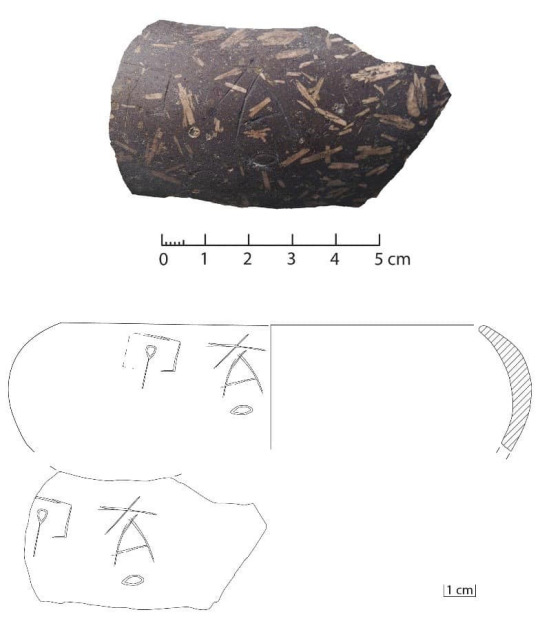
A fragment of a stone vessel recently found in the tomb of Queen Merneith. It has an incised inscription with her name on the right and the mention of the royal treasury on the left. Photo courtesy of EC Köhler, M Minotti.
Köhler specified that Merneith, also known as Meret-Neith, may have been in charge of the treasury among other government offices, supporting the idea of her historical significance. She is the only 1st-Dynasty woman whose tomb has been uncovered in Abydos so far.
“Considering that these are the remains of people’s lives and actions from 5,000 years ago, we are stunned every day at the amazing detail we encounter during our investigations, including the perfectly preserved grape seeds, craftwork and even footprints in the mud,” Köhler said over email.
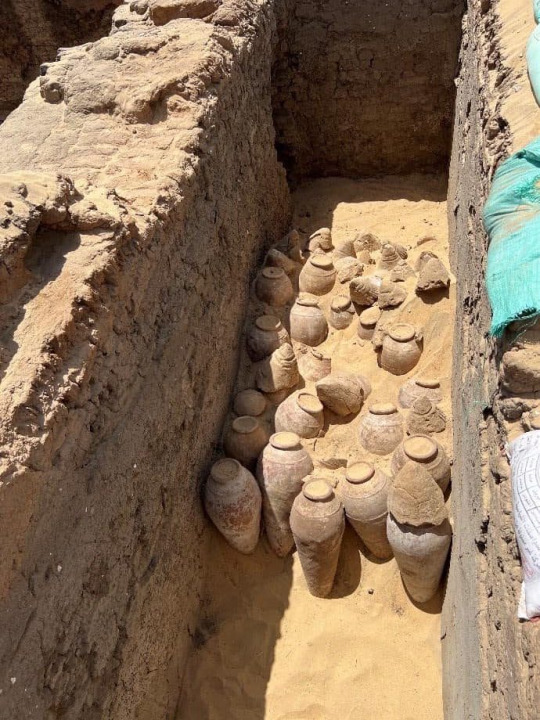
The wine jars are seen during the excavation of Merneith’s tomb. Photo courtesy of Egypt’s Ministry of Tourism and Archaeology

Egypt’s Tourism Ministry highlighted hundreds of 5,000-year-old wine jars found in the tomb in the Umm al-Qaab area in Abydos, one of the oldest cities in Egypt located about 354 miles south of Cairo. Photo courtesy of Egypt’s Ministry of Tourism and Archaeology
Discoveries made in the dig also “challenge the long-held belief in human sacrifice,” Köhler added in the news release.
Next to Merneith’s burial site, archaeologists found a group of 41 tombs for her courtiers and servants, indicating these chambers were built during different periods of time.
“This observation, together with other evidence, radically challenges the oft-proposed, but unproven idea of ritual human sacrifice in the 1st Dynasty,” Köhler said.
The news release highlighted the discovery of hundreds of 5,000-year-old wine jars that had never been opened. The archaeological team—hailing from Egypt, Germany and Austria—found the remains of wine inside.
Mustafa Waziri, Secretary General of Egypt’s Supreme Council of Antiquities, said in a statement that the discovered jars are large in size and “in a good condition of preservation.”
“Some of them are very well preserved with their jar stoppers still intact,” Köhler said.
#women in history#Discoveries in Archaeology#Egypt#Ancient Egypt#queen Merneith#1st Dynasty#Abydos#Queen Meret-Neith#5000 years ago#Umm al-Qaab
283 notes
·
View notes
Text
Very cool stuff! I just really wish people would stop writing sentences like this:
There’s evidence to suggest that Queen Merneith might have been a ruler of Egypt on her own. This idea is based on official records.
and instead write sentences like this:
Queen Merneith was a ruler of Egypt on her own based on official records from the time.
Far, far too often people couch ruling Queens in a bunch of maybes and could have beens when the records from the time are generally very clear. The thing that has stopped some Egyptologists (usually the earliest ones) from saying outright that this or that woman was a ruling queen, full stop, is sexism. That's it. Sexism. No other real reasons.
I have a whole TED Talk on how the story of Hatshepsut has been told over time and how it shines a spotlight on the sexism of Egyptology as a field.
Anyway, all hail Queen Merneith!
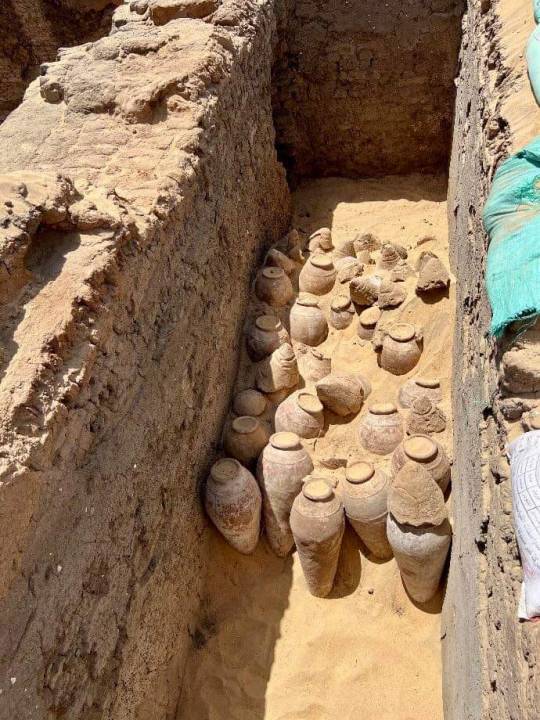
Archaeologists Uncover 5,000-Year-Old Wine in Egypt
A new discovery has been made by an archaeological team from Egypt, Germany, and Austria working in Upper Egypt. They found some 5,000-year-old wine inside sealed jars that had never been opened.
This discovery was made in Queen Merneith’s tomb in Abydos, Sohag. In addition to the ancient wine, the team also found furniture that was used for funerals.
Mostafa Waziri, who is the Secretary General of the Supreme Council of Antiquities, shared on Sunday that these old jars are big and in good condition.
Dietrich Raue, who is the Director of the German Archaeological Institute, added that the team also found out more about the life of the ancient queen and the time she ruled.
When they looked at the writings on one of the tablets found in the tomb, they discovered that Queen Merneith had a significant role. She was in charge of important government offices, explained Dietrich Raue.
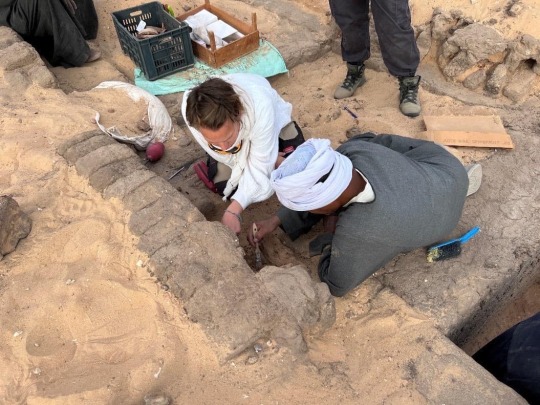
Raue also mentioned that the team is still working diligently to find out more about this enigmatic queen’s life.
Christiana Kohler, who leads the mission, revealed that their research into the tomb has revealed that it was constructed using materials like raw bricks, clay, and wooden planks.
Kohler pointed out that Queen Merneith’s royal tomb in Abydos is possibly the only one from the First Dynasty that has been found up to this point.
“This observation, together with other evidence, radically challenges the oft-proposed but unproven idea of ritual human sacrifice in the 1st Dynasty,” Kohler stated.

Additionally, she mentioned that there are 41 tombs near the queen’s tomb, which belong to her advisors and servants. Queen Merneith was the first female pharaoh
There’s evidence to suggest that Queen Merneith might have been a ruler of Egypt on her own. This idea is based on official records.
If this turns out to be true, and the earlier royal wife, Neithhotep, didn’t rule independently, then Merneith could be considered the first female pharaoh and the earliest queen who ruled on her own in recorded history. She governed around 2950 BC for a period that we’re not sure about, according to Wikipedia.
Merneith’s name, which means “Beloved by Neith,” has symbols related to the ancient Egyptian deity Neith on her stele. She might have been the daughter of Djer and likely the senior wife of Djet.
Being Djer’s daughter would make her the great-granddaughter of Narmer, the first pharaoh to unite Egypt. She was also the mother of Den, who succeeded her as ruler.
By Abdul Moeed.
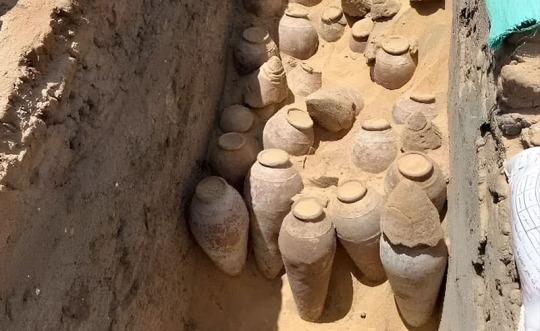
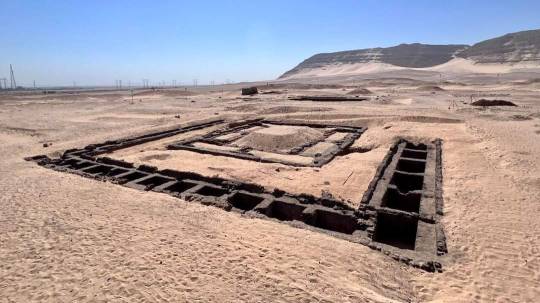
#Queen Merneith#ancient egypt#egyptology#egyptology sure can be full of sexism#ruling queens of egypt
112 notes
·
View notes
Text
When Women Ruled the World: Six Queens of Egypt by Kara Cooney

Read time: 6 Days Rating: 3.5/5 Stars
The Quote: Once upon a time, there were women who ruled the world. Six of them—Merneith, Nerferusobek, Hatshepsut, Nefertiti, Tawosret and Cleopatra—climbed the highest the wielded the most significant power: not as manipulators of their menfolk but as heads of state. Each started as a queen—a mere sexual vessel of their king—but each became chief decision-maker, five of them served as king outright. — Kara Cooney
When Women Ruled the World is perhaps unsurprisingly divided into six sections, one for each of the six queens, an introduction and a conclusion (both of which are on a theme). The six queens are Merneith, Nerferusobek, Hatshepsut, Nefertiti, Tawosret and Cleopatra. There are other women of power noted some are queens others are just women in positions of power in the Egyptian system. These include Neithotep, Tetisheri and Ahmes-Nefertari. The Queen/ King's Horus names are included and explained, all of them are interesting. Nefertiti and Hatshepsut's particularly so. A suggestion for those new to academic non-fiction, if you have an interest in the added detail provided by the notes, try using a second bookmark. But the narrative style used by Kara Cooney means you can skip them with ease. Same are added commentary, some are simply sources and some are where to look for more information.
🤎 Merneith — Queen of Blood (ca 3000-2890 B.C.) Merneith is the first of the six queens ruling as a regent for her son, Den during the 1st dynasty. Her entry acts as an overview of the kingship in ancient Egypt and the role of the Queen in it. Merneith provides something of a fascinating study in brutal strength and the things one must do to survive. Little is truly known of her really but I like the way this is written. The style empowers her and allows her ferocity to shine. As much as this is about the women Den himself is interesting, The First King of Upper and Lower Egypt. Den must have greatly respected Merneith burying her in a tomb fit for a king though with fewer human sacrifices (nothing to do with gender everything to do with afterlife necessity).
💚 Nerferusobek — The Last Woman Standing (1777-1773 B.C.) Nerferusobek has one of the best name meanings, beauty of Sobek. "Named for the fierce god of the Nile inundation, a deity of aggressive sexuality and violent fecundity." (p.77). Her crowned names are Beloved of Re; Daughter of the Powerful One; Mistress of the Two Lands; Stable of Appearances. This entry continues the discussion on succession discussing royal reproduction practices, including harems and a quite interesting section on incest (all neat logic no ick factor). There is an insightful and logical comment on harems that I quite appreciated. Her subtitle comes from why she was even sitting on the Horus Throne, Nerferusobek was the last royal of the 12th Dynasty, a product of incest (probably) causing sterility. She perhaps willingly but perhaps reluctantly took the throne to steady the ship. She had little to gain and was little threat to the status quo, with no chance of a male heir. Her short reign allows the board to be reset and allowed all the major power players to get their viable sons into position for the start of the next dynasty. Nerferusobek is almost the exact opposite of her female predecessor, it is easy to admire her patience and intelligence.
💛 Hatshepsut — Queen of Public Relations (1473-1458 B.C.) "Hatshepsut broke all the rules."(p.99) is the first line of this section and it is the perfect summation of her rule. Let's start with the pronunciation of her name as included by Kara Cooney Hat-shep-suit. One of the cutest moments in this section is what the young princes were called... nestlings look it made me smile okay. There was an interesting moment for me. The extremely young pharaoh, the two-year-old on the throne, could only happen in ancient Egypt with its focus on mythos and god-kings. Anywhere else would be civil war. Cooney has a great reading on Hatshepsut's potential romantic attachments. They weren't needed for her to maintain power, there was little place in the historical record for them. I did like the section on Hatshepsut and one day I will get around to reading Cooney's Hatshepsut work but not today. This is the longest section of the six, unsurprising really, Cooney wrote The Woman Who Would Be King dedicated entirely to Hatshepsut. As that book does exist there is less discussion and commentary in the notes they are nearly entirely sources. In some ways, I would consider her the opposite side of the coin to Merneith. Where Merneith held her position with strategic blood and violence Hatshepsut used ideology and human relations. Especially ideology.
For her countrymen there was no longer any point referring to her as "queen." That title was only used for women subservient to their sovereign. — Kara Cooney (p.84)
🧡 Nefertiti — More Than Just a Pretty Face (1338-1336 B.C.) Ideology was also important in Nefertiti's reign. Nefertiti was actually treated as an equal to her husband during his reign. An equal female to his male god. (Because yes he was a 🤡) What is clear is that in any other time, any other place, her husband, the completely bonkers Akhenaten would likely have faced regicide. There isn't a consensus that she even ruled alone, if she did she ruled with her daughter taking the role of Queen, the feminine role to her masculine. So much of everything around her is dependent on which school of Egyptology you belong to. It can be difficult. Was she ever a King in her own right? 🤷🏼♀️ Nefertiti is... complicated. It had to make many comments on her. So much of Nefertiti's reign in her own right is a matter of superposition. But I'm not even sure I knew that I ever knew the potential connection between King Tut and Nefertiti.
💙 Tawosret — The Survivor (1188-1186 B.C) Tawosret comes from a very different period of Egyptian history. She was needed by Egypt but not welcome. Women were greatly distrusted in any position of power. She is a mixture of all the previous queens except maybe Nefertiti. It all starts with a discussion of how times had changed in Egypt and the Ramesside period. Her crowned names are Daughter of Re, Beloved of Amun; Mighty Lady, Chosen of Mut; Strong Bull, Beloved of Ma'at; Founder of Egypt, who vanquishes foreign countries. Using the title Chosen of Mut is a brilliant ideological move, ditto Beloved of Ma'at. Mut was a mother goddess, her name means mother, she's a primordial deity. Ma'at was a deity tied to balance and justice, a key to the processes of entering the afterlife. All these women knew how to manipulate the greek pantheon for their own power. There is a lovely quote in here about human society and feminine rule. "Many of history's women could rise to power only within extraordinary crisis and, when the immediate predicament had abated, were unceremoniously pushed aside. Indeed, the catastrophe itself was usually blamed on the woman's rue, a Catch-22 if there ever was one." (p.240). Tawosret feels like something akin to one of the British succession crises (there have been three), but one, in particular, ended with a queen on a throne decided from a piece of genetics.
💜Cleopatra — Drama Queen (51-0 B.C.) If you are going to know any of the Queens it will definitely be Cleopatra. Cleopatra was a true power player, a power player that would likely succeed even in the modern-day, maybe more so in the modern-day. Sex is power and she was totally unafraid to use it but that is far, far from all she was. Cleopatra was also strategic, intelligent and openly ambitious. Even if you know Cleopatra you will likely find information in here you don't know. For example, Cleopatra was in Rome when Ceaser was assassinated or the import of Ceaserion. There was an amusing moment for me when I realised Cleopatra essentially bought Mark Antony, she wanted his power for some form of legitimacy, he needed money to pursue his military campaigning. Cleopatra's section ends with a quick section on what happened to her children. While her sons were killed her daughter, Kleopatra Selene was married to a Roman ally and well. She went on to become a queen and clearly inherited her mother's intelligence. What I didn't know was that Kleopatra Selene and Juba II's son was killed by Caligula just for being descended from Marc Antony and Cleopatra.
I did enjoy this. I enjoyed learning about new powerful women. Women who used power in different ways to maintain the stability of their Egypt and their position. There is some well-written background included too, like the way an heir was chosen and reproductive practices. I had completely missed in all my time reading about ancient Egypt the connection between Nefertiti and Tut. I do appreciate the use of the modern to help readers understand, Trump, Clinton, the Saudi Royal family and just general or universal expectations moments experienced by women.
Let me justify the rating. While I was reading this wasn't a 3-star book. But it feels more like a 3.5-star book upon reflection, I'm rounding down. Cleopatra's section let me down a little. I was confused for quite a bit of it, to be honest, it was a bit of a slog to get through. In the previous paragraph, I mentioned the moments experienced by women, that is also a bit of a flaw. This feels like it is squarely aimed at women. And perhaps relying too much on female experience and contemporary references.
#when women ruled the world#six queens of egypt#kara cooney#nonfiction#book review#ktreviews#read 2022#merneith#hatshepsut#nefertiti#cleopatra#tawoset#nerferusobek#booklr
12 notes
·
View notes
Text

Queen Merneith
#art#africanart#afrikan beauty#black history#ancient queen#kush#kemet#fantasyart#african#african queen#africanroyalty#pharoah#black beauty#nubianroyalty#nubian art#nubian queen#queen of sheba#queenofpharoahs#history#higher self#black women#imagination#afrocentricart
56 notes
·
View notes
Note
Hapshepsut?
Oh, you guys are funny. I make a note in my post about the oddity of people coming into my inbox with a single word prompt and that I have no idea how to respond except with a handful of information about the prompt, and now it's a real thing? That's just what I'm supposed to do?
Well, I might as well do so.
The modern legacy of Hatshepsut is dominated entirely by her womanhood. It completely disregards all of her accomplishments as a great and wealthy Pharaoh presiding over a time of great prosperity for Egypt, and it also overlooks the political and cultural climate of the time, which is as confusing as it is complicated.
This is much longer than my previous go about Ramses I, so I'm putting it under a read more.
Hatshepsut's Beginnings
When the layman thinks of Hatshepsut, they will think that she is the first female ruler of Egypt. This is their first mistake. There were many regents of Egypt; mothers who ruled on behalf of their young sons, who were not yet old enough to fully claim the throne. Beyond that there was also the female King Sobekneferu (12th Dynasty), as well as two Queens very early on in Egyptian history who might've been Pharaohs in their own right; Neithhotep (Early 1st Dynasty) and Merneith (1st Dynasty), both named for the warrior Goddess Neith, who held considerable importance in early Egyptian history. Both of these Queens have inscriptions and monuments attesting to their rule, but due to a lack of complete concrete evidence, it is difficult to now say whether they were regents or Pharaohs. Sobekneferu, from the 12th dynasty, was the first woman to take on the full royal titulary, assuming the position and title of Pharaoh completely. While her existence and rule is fully affirmed, there is little evidence left in the way of her accomplishments, as she ruled as the last Pharaoh of the 12th dynasty.
Khnumetamun Hatshepsut herself was born in 1507 BC to the Pharaoh Thutmose I and his Great Royal Wife, Ahmose. Her name, meaning 'Foremost of the Noble Women' was suiting to her––later in life she would be married to another one of her father's sons, Thutmose II, who was birthed of a secondary wife named Mutnofret. She was married before the age of 20 and assumed the highest standing title a woman could gain at the time; the God's Wife of Amun, giving her more power than even a Queen could achieve. To understand the importance of Hatshepsut even at this time, we must understand what it was to be the God's Wife of Amun. And remember, all this power and prestige is before she ever even became regent to her husband's son.
The God's Wife of Amun was a position held in Thebes, modern-day Luxor, and called Waset in ancient times. The title originates from the Middle Kingdom, and at that time, it was merely an honorific title for a noble woman who assisted the High Priest of Amun at Karnak Temple in his duties. By the New Kingdom, which was Hatshepsut's time, the God's Wife of Amun was powerful enough to influence policy and held considerable power and prestige, the peak of which was reached in the 3rd Intermediate Period, when a God's Wife of Amun ruled over Upper Egypt. The typical duties of a God's Wife of Amun were that of a high priest, and she would essentially be the female counterpart of the high priest of Amun, and took on many of his responsibilities alongside him. But the rewards for it were also plenty: "tax-exempt land, housing, food, clothing, gold, silver, and copper, male and female servants, wigs, ointment, cosmetics, livestock, and oil." (God's Wife of Amun, World History Encyclopedia, Joshua J. Mark) She would preside over the festivals of Amun and would be considered His consort, making her a divine being.
So this was Hatshepsut's position which was gifted upon her around the same time she was married to her half-brother, Thutmose II. Together they had a daughter whose name is Neferu-Ra, but this was their only child. The only viable heir to the throne after Thutmose II would have to be a son, which only came about through Thutmose II's lesser wife, Isis, who birthed Thutmose III. But Thutmose II, Hatshepsut's husband, died relatively soon after Thutmose III came to be, and so Thutmose III, the young son, could not fully be given the throne. Instead, Hatshepsut was made regent, and assumed all duties of state and Pharaoh while Thutmose III was growing up.
Proclaiming Herself Pharaoh
It was in the 7th year of her regency that the well-known history occurred. Hatshepsut crowned herself sole Pharaoh of Egypt. She assumed all royal titularies, titles, and names befitting a Pharaoh, but inscribed all of these using feminine forms. She passed down her title of God's Wife of Amun to her daughter, Neferu-Ra, and had her married to Thutmose III, likely in an attempt to consolidate power, and began to carve images of herself as a male Pharaoh.
I have commented on Hatshepsut before because some people like to claim that Hatshepsut is the world's first transgender person. This is incorrect. If she had wanted to represent as male, she would've gone about it differently, and to begin with, she would've changed her name. As I stated earlier, her name means "Foremost of the Noble Women"; this is a female name, and it would've been obvious to any Egyptian of the time that this was a woman. Instead, her representation as a male was to ensure the people knew she was not a Queen, but a full-fledged Pharaoh. And as I mentioned just previously, all her names and titles used feminine grammatical forms.
She is a complicated character, and one that will likely never be fully understood. But one certain thing about Hatshepsut was that she was smart. By marrying her daughter to the 'King' Thutmose III, she created a safety net for herself; if she was removed from the throne and Thutmose III was crowned, then she would still hold considerable power as the mother-in-law of the Pharaoh. She further legitimized her rule as Pharaoh by proclaiming that she was not just Amun's ritual wife, but His daughter, as well.
In the carvings and paintings in Hatshepsut's mortuary temple at Deir el-Bahari, Hatshepsut tells the story of how Amun appeared to her mother, Ahmose, in the form of Thutmose I, her father.
"He [Amun] in the incarnation of the Majesty of her husband, the King of Upper and Lower Egypt, [Thutmose I] found her sleeping in the beauty of her palace. She awoke at the divine fragrance and turned towards his Majesty. He went to her immediately, he was aroused by her he imposed his desire upon her. He allowed her to see him in his form of a god and she rejoiced at the sight of his beauty after he had come before her. His love passed into her body. The palace was flooded with divine fragrance." (van de Mieroop, 173)
This interaction made Hatshepsut a demi-God. But this was also not enough; she made claims that Thutmose I, her father, made her a co-ruler with him.
"Then his majesty said to them: "This daughter of mine, Khnumetamun Hatshepsut—may she live!—I have appointed as my successor upon my throne... she shall direct the people in every sphere of the palace; it is she indeed who shall lead you. Obey her words, unite yourselves at her command."" (Seawright, Caroline (6 November 2000). "Hatshepsut: Female Pharaoh of Egypt")
She claimed that Amun had sent an oracle foretelling of her rise to power.
"Welcome my sweet daughter, my favorite, the King of Upper and Lower Egypt, Maatkare, Hatshepsut. Thou art the Pharaoh, taking possession of the Two Lands." (Breasted, James Henry (1906). Ockerbloom, John Mark (ed.). Ancient Records of Egypt: Historical Documents from the Earliest Times to the Persian Conquest)
She also represented herself as the direct successor of the Pharaoh Ahmose I, who started the 18th Dynasty.
That last bit may seem unimportant if you do not know the history behind Ahmose I. Ahmose I came about during the 2nd Intermediate Period, a time in which Egypt was split into three sections. Lower Egypt, the delta, which is to the north, was ruled by foreigners––the Hyksos, who were much despised by the native Egyptians, who ruled only a section of Egypt from Thebes. Then far the south, the Nubians ruled their own section of Egypt. What's important here, however, is the Hyksos rule. The Hyksos were commonly referred to as the Asiatics, and likely originated from the Levant, referring to themselves with Western Semitic names. They were seen as cruel and oppressive rulers, and while this was likely far from the truth, when we concern ourselves with the cultural standpoint of 18th Dynasty Egyptians, we only need to understand their viewpoint and opinion of the Hyksos. Ahmose I, ruler of Thebes, successfully drove out the hated Hyksos from Egypt, and reinstated Theban rule over the delta in Lower Egypt. These actions made him a much-beloved figure in the eyes of the ancient Egyptians, and this is why Hatshepsut proclaiming herself as a direct successor of Ahmose I was a smart move––she correlated herself with freedom from oppression and a somewhat legendary figure, who had ruled over Egypt some 80 years previous to her.
Actions As Pharaoh
Consolidating her rule, gaining power, and ensuring that power would stay were not the only things she accomplished, even if that is what most people recognize her for. She also completed a staggering amount of construction projects for temples, protected the borders of Egypt, led military expeditions into Syria and Nubia, and a rich trading expedition to the mythical land of Punt, which is presumed to be somewhere in modern-day Somalia. She was in control of a massive amount of wealth, without which it would not have been possible to assume so many building projects.
"Hatshepsut was able to exploit the wealth of Egypt's natural resources, as well as those of Nubia. Gold flowed in from the eastern deserts and the south: the precious stone quarries were in operation, Bebel el-Silsila began to be worked in earnest for sandstone, cedar was imported from the Levant, and ebony came from Africa." (Betsy M. Bryan, Shaw, 229-231)
Inscriptions at her mortuary temple in Deir el-Bahari go into detail about her expedition to Punt, as well, describing an immense amount of wealth.
"The loading of the ships very heavily with marvels of the country of Punt; all goodly fragant woods of God's Land, heaps of myrrh-resin, with fresh myrrh trees, with ebony and pure ivory, with green gold of Emu, with cinnamon wood, Khesyt wood, with Ihmut-incense, sonter-incense, eye cosmetic, with apes, monkeys, dogs, and with skins of the southern panther. Never was brought the like of this for any king who has been since the beginning." (Lewis, 116)
Her temple was such an immense work of art that it is considered by many to be one of the finest temples in Egypt, whose craftsmanship exceeded any Pharaoh before her and was only ever matched by Ramses the Great (Ramses II). She built throughout the country to such an extent that there are very few museums who concern themself with Egyptian history who do not have a piece of Hatshepsut's work. She added tremendously to the complex of Karnak at Thebes for the glory of Amun, and erected two giant obelisks there, alongside many other obelisks raised in other parts of the country. The Karnak complex is made up of three different precincts; the precinct of Amun, the precinct of Montu, and the precinct of Mut. The precinct of Mut had been ravaged during the Hyksos rule, and so Hatshepsut rebuilt and restored Mut's great temple in Thebes, once again honoring the Gods with her wealth.
Overall, she was an immensely successful Pharaoh. She added to the great temples of Egypt and built new temples, simultaneously giving honor to the Gods and employing the people. In these temples she performed rituals and rites traditionally reserved for the Pharaoh, which further confirmed her power and status reigning as a male Pharaoh. She led conquesting military campaigns into Syria and Nubia, protected the borders of Egypt from foreigners, conducted highly successful and bountiful trades with the people of Punt, who were highly rich in gold, and built one of the most beautiful and iconic mortuary temples known today, influencing the location of the future Valley of the Kings.
Death of Hatshepsut
Hatshepsut's death is unfortunately not well understood. Her body was moved several times due to complications with lineage, burial, and the right to the throne. There is a mummy that is proposed to be Hatshepsut. This mummy has a missing tooth in her jaw, and Egyptologists are in possession of one of Hatshepsut's teeth, found in one of her canopic jars. The empty space and the tooth fit perfectly together, so it is proposed that this mummy is Hatshepsut. However, later on, the tooth was identified to be a molar from the lower jaw, whereas the missing tooth from the mummy is in the upper jaw. There is a lot more to this than I am writing about; this is the simplified version because there's a lot of scientific know-how one needs to fully understand the complications of trying to identify a nameless and displaced mummy.
If this mummy is Hatshepsut, then Hatshepsut died from bone cancer. Queens in the family of Hatshepsut are known to have had genetic skin irritation, and the lotions used by the Pharaoh were a carcinogenic, benzopyrene skin lotion, meaning that over time, as Hatshepsut attempted to soothe her irritated skin, she would've been giving herself cancer. Alongside that, she also had bad teeth, which is why one tooth is gone from her jaw––it was removed, and later caused an abscess, which may have also contributed to her death.
Removal from History
Eventually, as we all know, Hatshepsut was stricken from the record. Her names were carved out, smoothed over, or replaced with the names of her step-son, Thutmose III, who took over as Pharaoh when Hatshepsut passed into the west. Many images and statues of her were dismantled, destroyed and buried, and there was an attempt to wall up her monument at Karnak. The majority of this historical re-writing took place at the end of Thutmose III's reign, when he was co-reigning with his son, Amenhotep II.
It is not entirely clear why this was done, but there are several theories, and I find it likely that they were all true in some way, and all contributed to the defacing of Hatshepsut's legacy. For one, rule of Egypt is a traditionally male role, as is shown in the first king Osiris and His wife, Isis, who were mythologically the first to rule over Egypt. Egypt was very dependent on the idea of Ma'at, which represents truth, justice, and most importantly, balance. Having a female Pharaoh was an upset of the balance and an upset of tradition, so it might've been seen as prudent to erase Hatshepsut's memory of female rule. Another factor is that the reusing of monuments was a common and popular practice of Pharaohs; they would take the already-built monuments of previous Pharaohs and inscribe their own names in them, claiming they were built by them. This saved money and resources. The last factor that I would consider a prime reason would be Thutmose III's son, Amenhotep II.
Amenhotep II had a very shaky claim to the throne. He was not the son of the Great Royal Wife; instead, he was the son of a lesser wife, Merytre-Hatshepsut. Amenhotep II was also not the eldest son. The eldest son of Thutmose III was born of the Great Royal Wife Satiah, and his name was Amenemhat. But both Satiah and Amenemhat died, and so Amenhotep II was who Thutmose III resorted to when it came to passing on the throne. Amenhotep II, who was insecure in his claims to the throne, usurped many of the accomplishments, deeds, and monuments of Hatshepsut. He neglected to record the names of his Queens, and he eliminated the giving of power to women, erasing the titles of the Gods Wife of Amun, and other such positions which had the chance to give any power to women. In my opinion, truly an unpleasant man. But fortunately these titles were restored by his son Thutmose IV, and we are not here to talk about Amenhotep II.
Overview
Hatshepsut was a great Pharaoh who accomplished great things and presided over an incredibly prosperous time in Egyptian history. This is likely why her name was stricken from the record and the name of Sobekneferu, the previous Queen-Pharaoh, was not. Sobekneferu presided over a time of chaos, so it was not important to remove her, as her rule could stand as an example as to why it was against Ma'at for a female to rule as Pharaoh. But Hatshepsut was extremely successful, and for that, she was removed. She built great monuments, added to the prosperity and health of the people, honored the Gods, and was one of the most powerful Pharaohs in Egyptian history. We will likely never know why she did all of this; why she was dissatisfied with her position as the God's Wife of Amun, why she proclaimed herself Pharaoh over her husband's son. But nothing bad seemed to ever come from her reign, and she is now remembered as one of the most iconic figures in ancient Egyptian history.
#Hatshepsut#ancient egypt#ancient history#history#egyptology#im just kidding about the intro btw.#i love doing these#like SO MUCH#so if you actually do want a little essay about a specific topic#send it my way
70 notes
·
View notes
Text

𝓰𝓲𝓻𝓵 𝓹𝓸𝔀𝓮𝓻,
Ancient egypt, a time where women actually had authority to themselves, though limited, better than other civilizations.
Here are 15 interesting facts about woman ruling ancient egypt :
Some women ruled when the male heir was too young.
Ahhotep ruled egypt, because her 10 year old son was too young to rule egypt. She ruled until he turned 16.
The Egyptians actually liked Ahhotep, since her reign brought the land peace.
Ahmose (ahhotep's mother) honored his mother by placing a necklace with fly pendants in her tomb (gold fly shaped pendants have been interpreted as braveness)
The first female Pharaoh (that we know of) is called Merneith, and there was a time where experts doubted her as a Pharaoh, let alone existence.
According to a story, the female ruler Nitoctis murdered her brothers assasin.
The famous Nefertiti, was a very beautiful woman, and her name means 'the beautiful woman has come'.
Many artworks depicts Nefertiti and Akhenaten (her husband, and the Pharaoh at the time) as equals.
After aten (religion established by Akhenaten) was declared as Egypt's main god, Nefertiti changed her name to neferneferuaten, and it means 'aten is the most beautiful, nefertiti'.
Nefertiti was Tutankhamun's stepmother.
Around 1760 b.c, amenemhet died, and there was no male to take the throne, so his halfsister sobeknefru became the Pharaoh of egypt.
Tiye was a commoner, but she married Amenhotep iii.
Unlike other queens, tiye's name was engraved with her husbands name on monuments.
Tiye identified with the cow goddess, Hathor, and she was the first queen to wear hathors headdress (horns and a sundisk)
Cleopatra II revolted against her husband (and also her brother) Ptolemy VIII, when he demanded a divorce and married her daughter from a previous marriage.
𝓻𝓮𝓼𝓸𝓾𝓻𝓬𝓮𝓼 : (click to open)
National Geographic Kids 1,000 facts about ancient Egypt (book)
Ecosystem publishing, Hans Anders in the name of Cleopatra.
website link #1
website link #2
website link #3
website link #4
#moonyarchives#ancient egypt#ancient history#egyptology#egypt#cleopatra#nefertiti#hathor#Pharaoh#history#history lesson#literature#egyptologist#women#women rule#ancient egypt mythology
7 notes
·
View notes
Photo

Rare Find: 5,000-Year-Old Wine Jars Discovered by Archaeologists in Egypt | Wine Spectator
What were people drinking 5,000 years ago in the southern Egyptian city of Abydos? We already knew locals were filling their cups with beer, as Abydos was home to a massive brewery at that time. But as we’ve recently learned, it seems there was another tipple on the beverage list.
On Oct. 1, an international archaeology team announced the extremely rare discovery of dozens of wine jars at the Um Al-Qaab archaeological site within Abydos, giving us an even clearer image of Bronze Age hospitality. (The excavation represents the combined efforts of the Egyptian Ministry of Tourism and Antiquities, the Archaeological Institute in Cairo, the University of Vienna, the University of Technology in Vienna and Lund University.)
Archaeologists discovered the jars while digging at the tomb of Queen Merneith (aka Merit-neith), the royal consort of the pharaoh Djet in the First Dynasty. Merneith later ruled Egypt as a regent during the reign of her young son, Den, around the year 2950 B.C.E., making her one of the earliest-known women rulers in recorded history. While historians debate the full extent of Queen Merneith’s authority, researchers found inscriptions at Abydos that indicate she did, indeed, pull the levers of government. Now, about that wine …
“We found about 50 intact wine jars in one context and the fragments of hundreds of others,” Dr. E. Christiana Köhler, the excavation’s principal investigator and project director, told Wine Spectator via email. “Some of them were still sealed with ceramic lids and mud sealings. The excavations are ongoing, and it is possible that we’ll find more wine jars.”
If that wasn’t exciting enough, most of the jars still hold quantities of “well-preserved” grape pips and other residue. Per Köhler, while this wine probably came from vineyards within Egypt, chemical analysis is ongoing, so time may tell what type of wine this is. (It’s already been 5,000 years; what’s a few more?) ...
My BFF Sue hipped me
#Ancient Egypt#Merneith#Archaic Egypt#Early Dynastic Egypt#First Dynasty#1st Dynasty#Wine#Archaeology#Ancient Oenology#too cool
4 notes
·
View notes
Text
ANCIENT EGYPTIAN HISTORY
Each book will be title followed by author with a summary and thoughts below
Welcome to my (mega) post about all my book recommendations for Ancient Egyptian history! (Mythology will be a separate post)
The very end will say where I got these books, and while I unfortunately cannot find links to add (as I don't know if they will always be available) I can promise to add a small summary and my own thoughts on them
Please note that you can send in your own recommendations, these are for everyone and I want to add as many as I can, you can even comment or message me why I should add/remove a book from the listings.
Please know I own all these books (and more to come with each update,) on a shelf, have read these, and will give my personal opinion (so if they clash with yours, that's completely fine, id love to hear your opinion!)
Let's begin!
When women ruled the world; by Kara Cooney
When women ruled the world (WWRW) is about the political status, very briefly written, about the solo queens of Egypt who made their names into the history books as "women kings" of the times.
Personal opinion: I like this book, it details the potential of Merneith, Neferusobek, Hatshepsut, Nefertiti, Tawosret, and Cleopatra's lives before and after becoming the rulers of Egypt, each in their own dynasty and how different the times were
Why recommend the book? Well, if you want to have a brief (about 40-60 pages each chapter) introduction to these women of Egypt, then this is the book for you, it's somewhat bias in the epilogue, but most of it is written with solid understanding of the dynasty's and their potential lives
Ancient Egypt; by Lionel Casson
This book is about 158-165 pages long (minus the appendix/chronology/acknowledgements/and index), it's very short, and gives you an introduction into the world of ancient Egypt, each section is stock full of information (about 8 small chapters) that go from beginning to end of the ancient world
Personal opinion: my very first book about ancient Egypt! While it wasn't my introduction to the world of the ancient desert (that was a time magazine my brother gave me at age 4, hard to believe I'm an adult now), it did give me insight into how, beyond mummies and the dead were seen, the world was at the time
Why recommend? It's a great start for someone who you think might like the ancient world of Egypt, possibly a child to someone who's just interested but can't find a place to start that covers it all in short succession
Hathor's alchemy, the ancient Egyptian roots of the hermetic art; by Alison m. Roberts
This book is very straightforward, about how they viewed magic and used it, but also how it progressed over the years
Personal opinion: this book to me was, meh, not my favorite, as it wasn't as in depth as I personally wanted it to be about each little thing, but I did like it enough to keep reading
Why recommend? If you're interested in how magic/alchemy was used and progressed through the times, I suggest this book. There are about 260 pages of information (again, minus extra) with pictures, diagrams, and even foot notes (as many of these books have!)
Egyptian magic; by E.A.Wallis Budge
Very short, 233 pages and filled with information, including gliphs, pronunciation, and even use of said things. This book is for those who want more in depth on magic beliefs with unbiased narration.
Personal opinion: HOLY MOLY! Favorite author for this kinda thing, his stuff, perfect, not only is it indepth, but it's written well enough not much has to be explained heavily, there are pictures and gliphs, and words, and it's perfect when you want to look into stuff
Why recommend? If you want something simple, get this book, it's informative and doesn't hold anything relating to biased opinions or views
The ancient Egyptian book of the dead; by E.A.Wallis Budge
This version of the book of the dead, edited by Epiphanius Wilson A.M. is perfect for those who want a brief book on the book of the dead, both explained and translated
Personal opinion; this one is a good start for the book of the dead, a massive piece for Egyptology, it goes about the translations of prayer, the incantation usage, and even other text related, as well as a list of the deities from Egyptian myth
Why recommend? Great starter, there is a second one (i.e the next one on the list, also by E.A. Wallis Budge) that goes more in depth for this, but this is a skimming overview for the information
The Egyptian book of the dead (the papyrus of Ani), by E.A. Wallis Budge
This book goes further into depth, following translation and the original text itself from the papyrus (the language transliterated from the gliphs and symbols to the spoke pronunciation)
Personal opinion; if you are part of the Kemetic religion, I highly recommend this book for personal usage if you wish to write your own scroll of the dead! While I am not personally of the religion, I do think those of it will like this if one wishes to write their own scroll (or have one written for them) before their passing through Duat and eventually to Aaru
Why recommend? If you want more depth to the book of the dead, with original (transliterated) text and translation, this book is best, as it's unchanged and as accurate as possible
Egyptian hieroglyphs for complete beginners, by Bill Manley
This book includes ways to pronounce (with similarities to modern words and sounds) read, and write hieroglyphs, one of many languages used in ancient Egypt by then Egyptians. This book is similar to that of a work book, with understanding of how to explain the language
Personal opinion; I use this book myself, as someone interested in being an egyptologist, this book helps me understand and read the language of hieroglyphics, and being a step by step helps immensely
Why recommend? If you pair this with the next book, these will definitely help you understand the language well enough to be able to translate, and if you too have an interest in the field, you can get a head start!
Ancient Egyptian Phonology, by James Allen
This book explains how many languages were used in ancient Egypt, the various different versions, as well as how to pronounce and use them (however it's not a step by step work book like the previous)
Personal opinion; as I said before, pair this with the previous book and you can help yourself understand the language, it's a personal favorite of mine, and while many sounds are hard for me, practice makes perfect
Why recommend? Like stated before, it's good for those interested in learning the languages used, but it's also for those who want to write, understand, and even learn how they were used/spoken/and written depending where and when the time and place
(all books were bought from either barns and nobles, or books a million, both in store or online shipped, all books are read through, kept, and examined for biased and factual evidence)
5 notes
·
View notes
Text
Archaeologists Excavating the Tomb of Egypt’s First Female Pharaoh Found Hundreds of Jars Still Holding Remnants of Wine
The dig has also shed new light on the reign of the ancient queen.
— Adam Schrader | October 18, 2023
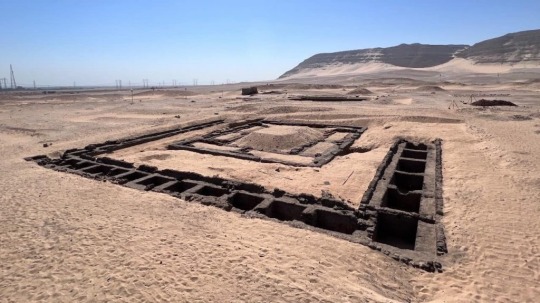
An archaeology team has discovered evidence that the Ancient Egyptian Queen Merneith “had a great position” and was responsible for the central government offices. Photo courtesy of Egypt’s Ministry of Tourism and Archaeology
Archaeologists digging in one of the oldest cities in Egypt have discovered evidence that sheds new light on the life of the ancient Egyptian queen Merneith, who ruled during the 1st Dynasty.
The excavation of a tomb in the Umm al-Qaab area in Abydos found an inscription on a “Stone Vessel” that provides new historical information about Merneith’s reign, during which she held “A Great Position” and was responsible for the central government offices, said Christiana Köhler, who led the dig.
“It has been speculated that Merneith may have been the first female Pharaoh in Ancient Egypt,” Köhler said in a news release, “but her true identity remains a mystery,”

A fragment of a stone vessel recently found in the tomb of Queen Merneith. It has an incised inscription with her name on the right and the mention of the royal treasury on the left. Photo courtesy of EC Köhler, M Minotti.
Köhler specified that Merneith, also known as Meret-Neith, may have been in charge of the treasury among other government offices, supporting the idea of her historical significance. She is the only 1st-Dynasty woman whose tomb has been uncovered in Abydos so far.
“Considering that these are the remains of people’s lives and actions from 5,000 years ago, we are stunned every day at the amazing detail we encounter during our investigations, including the perfectly preserved grape seeds, craftwork and even footprints in the mud,” Köhler said over email.
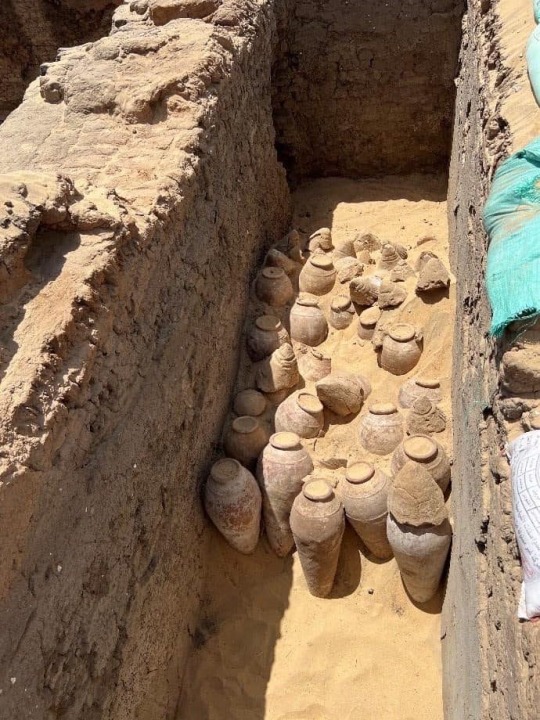
The Wine Jars are seen during the excavation of Merneith’s Tomb. Photo courtesy of Egypt’s Ministry of Tourism and Archaeology
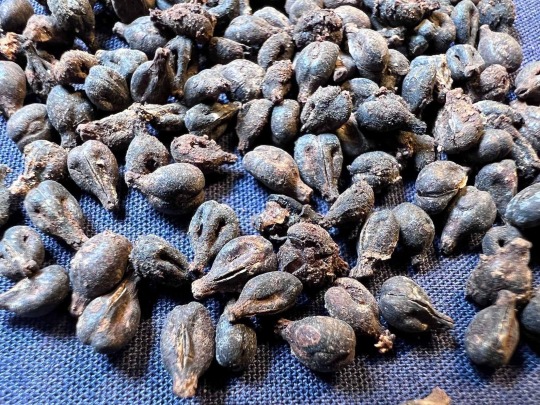
Perfectly Preserved Grape 🍇 Seeds: Egypt’s Tourism Ministry highlighted hundreds of 5,000-year-old wine jars found in the tomb in the Umm al-Qaab area in Abydos, one of the oldest cities in Egypt located about 354 miles south of Cairo. Photo courtesy of Egypt’s Ministry of Tourism and Archaeology
Discoveries made in the dig also “challenge the long-held belief in human sacrifice,” Köhler added in the news release.
Next to Merneith’s burial site, archaeologists found a group of 41 tombs for her courtiers and servants, indicating these chambers were built during different periods of time.
“This observation, together with other evidence, radically challenges the oft-proposed, but unproven idea of ritual human sacrifice in the 1st Dynasty,” Köhler said.
The news release highlighted the discovery of hundreds of 5,000-year-old wine jars that had never been opened. The archaeological team—hailing from Egypt, Germany and Austria—found the remains of wine inside.
Mustafa Waziri, Secretary General of Egypt’s Supreme Council of Antiquities, said in a statement that the discovered jars are large in size and “in a good condition of preservation.”
“Some of them are very well preserved with their jar stoppers still intact,” Köhler said.
#Archaeology#Ancient Egyptian QueenMerneith#Egypt 🇪🇬#Egypt’s First Female Pharaoh#Archaeologists | Jars 🫙 | Wine 🍷#Tomb | Umm al-Qaab area | Abydos#1st Dynasty#Egypt’s Ministry of Tourism & Archaeology#Stone Vessel#Christiana Köhler#Preserved Grape 🍇 Seeds | Craftwork | Footprints 👣#Mustafa Waziri | Secretary General | Egypt’s Supreme Council of Antiquities
0 notes
Photo

Couchman Creations: Pharaoh’s Pet stitched by perpetually_me.
A year ago my husband and I separated. He didn’t like me stitching. I present my divorce piece. A year almost to the day!
I’ve never finished a piece within a year before .
In between full time work and part time study and a child and dating 😉 and renovating and…
Next up is the sister piece to this which will become my “new life”? “next phase”? … piece
Pattern is Pharaoh’s Pet by Couchman Creations Sister piece will be Pharaoh’s Hound by same.
Merneith is the name of an early Ancient Egyptian Queen meaning “beloved of Neith”. And Neith was an Ancient Egyptian Goddess of creation, wisdom, weaving, and war.
0 notes
Text
obscure historical people you cry over ready go
#mine is merneith#first queen of egypt#and the king’s mother#i just love her a lot#ancient egypt#egyptian royalty#history#historical#comfort characters#but make it real i guess#dark academia#study#school#study or#light academia#academia#romantic academia
4 notes
·
View notes
Photo

Merneith was a queen from the very first dynasty of a unified Egyptian kingdom, with her husband Djet being that dynasty's fourth Pharaoh. When Djet passed away sometime before 2950 BC, their son Den would have been too young to take the throne, so Merneith would have acted as a ruling regent in his place (the exact length of her reign remains undetermined). Merneith may have actually been the second woman in Egyptian history to assume the throne temporarily, with the first one (Neithhotep) being none other than the spouse of the dynasty's founder Narmer himself.
In this picture, Merneith is wearing a combination of the red crown of Lower Egypt and the white crown of Upper Egypt, representing the union of these two regions into one kingdom under Narmer.
#ancient egypt#egyptian#kemet#african#black woman#dark skin#woman of color#woc#women in history#digital art#art
69 notes
·
View notes
Photo










Senwosret I
Amenemhat I
Montuhotep III
Niuserre [x 2]
Menkaure
Queen Hetepheres II
Qa’a [AKA Q’a Hedjet, Ka’a]
Den
Stela of Queen Merneith
12 notes
·
View notes
Note
Do you think that the evidence suggests that Neithhotep or Merneith ruled Egypt in their own right in their times? I understand that this is an ongoing debate.
Yes, and one we might not be able to definitively answer because of a lack of conclusive evidence, but that’s something that happens a lot in history anyway. Personally I consider it likely both ruled in their own right, however brief, because a female king is not exactly an unprecedented happenstance in ancient Egypt. Laypeople usually only really know Cleopatra and Hatshepsut, but there’s also e.g. Tawosret and Sobekneferu, and queen-mothers being regents for their sons is also well-attested, e.g. Ahhotep I.
So combining what we know of female rulers and regents throughout Egyptian history with the specific knowledge we have about Neithhotep and Merneith, yes, I think it’s fair to say they both likely ruled solo as king.
19 notes
·
View notes
Text

Jason about to seize the Golden Fleece, the stern of the Argo at the right, Terracotta column-krater (bowl for mixing wine and water), ca. 470–460 B.C.
“Jason, the captain of a small fleet of Thessalonian ships—and rightful heir to its throne—had led his entire crew into Hippolyta’s throne room not long after Queen Merneith’s arrival, pledging to protect the beauty of Themyscira and its Queen with their lives, and it is then that Hippolyta first lays eyes on the boyish twins from Thebes, Alcides and Iphicles.
Hippolyta had watched as they trembled, leaning slightly against one another and trying to stand tall, avoiding the eyes of the fierce Amazon warriors surrounding them, and she’d offered Jason a puzzled look and a stern reprimand: War is no place for children, Jason. You should have brought me their mother.”
#yes I just quoted myself#But the first time Hippolyta met Heracles she made a Yo Mama joke and I'm not even sorry
2 notes
·
View notes
Text
Woman Crush Wednesday!
In Ancient Egypt, women were regarded very differently than they are today. Women were in some cases given the honor of having the power to lead as Pharoah. In some cases, women lead as Pharoah in the case that their husband died and their son was too young to lead.
Merneith was a leader in the first dynasty (3000-2890 B.C.) who was believed to have been the first female Egyptian ruler. Not much is known about her rule due to the lack of records and how early her dynasty was.

Pictured above is a the funerary stela of Merneith.
Merneith was known by some as the “blood queen” due to the burial practices that they practiced during her time known as sacrificial burial. This involved the murders of over 200 people including family members, close friends, and servants who were believed to have been needed to help guide the spirit in the afterlife. These rituals were discontinued soon after the end of her rule. It is unknown how she died. Her name is listed in her son’s tomb, she is the only female on the list and was followed with the title “King’s Mother” on the seal.
Not much is known about her, but to me, she is super important to the history of Egypt since she was the first female ruler. Queens are some of my favorite historical figures, I love learning about how they got to power and learning about their personal lives. I really love this book I am currently reading now called “When Women Ruled the World” by Kara Cooney. Just a hint for next week, there is a very good chance my next WCW will be from this book.
9 notes
·
View notes